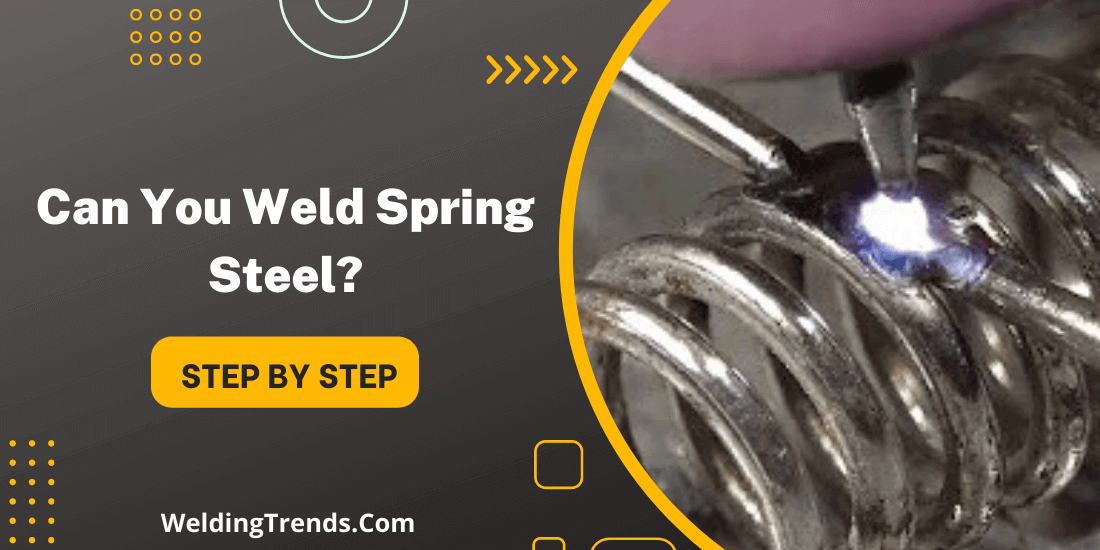People often ask if they can weld spring steel. The answer is, yes you can weld it, but there are some things you should know before you start.
Welding spring steel can be a bit of a challenge. The key is to use the right welding techniques and have the necessary equipment.
In order to weld spring steel, you need to have the proper welding equipment and practice using it. Spring steel is notorious for its high levels of heat resistance, meaning that if you’re not careful, you can easily damage the metal.
In this blog post, we’ll discuss how to weld spring steel and some tips to make the process easier. Stay safe while welding and have fun!
What is spring steel and what are its uses?
Spring steel is a type of carbon steel that is designed to be particularly elastic. It is often used in the production of springs and tension coils, as it can return to its original shape after being bent or stretched. Spring steel can also be used in the production of knives, as it is able to hold a sharp edge.
How to weld spring steel?
First step is to choose the right welding equipment. You will need a welder that is able to generate high levels of heat, as well as the proper welding supplies. Spring steel is very difficult to weld, so it’s important to have everything you need before you begin.
Some people recommend using a MIG welder, as they are generally easier to use and don’t require as much cleanup afterward. Others prefer TIG welders, as they can create stronger welds. Whichever type of welder you choose, make sure that you’re familiar with how it works before you begin.
Next step is to prep the spring steel for welding. This involves cleaning the metal and removing any rust or debris that could interfere with the welding process. Once the metal is clean, you will need to clamp it down so that it doesn’t move while you’re working.
Now you’re ready to start welding! Begin by heating the area you want to weld. You will need to use a lot of heat when welding spring steel, so make sure that your welder is set to the highest setting. Slowly run the welding rod along the seam, being careful not to overheat the metal.
If you’re having trouble getting the hang of it, don’t hesitate to ask a friend or professional for help. Welding spring steel can be tricky, but with a little practice, you’ll be able to do it like a pro!
Need more information on welding spring steel? Check out this video for a step-by-step tutorial.
Benefits of welding spring steel
There are many benefits to welding spring steel.
1. Helps to create springs and tension coils
The most obvious benefit is that it can help you create springs and tension coils that can return to their original shape. In addition, welding spring steel can also help you create knives that have a sharp edge.
2. Strong and Durable
Another benefit of welding spring steel is that it is very strong and durable. When properly welded, spring steel can withstand a lot of wear and tear. This makes it an ideal choice for applications where the metal will be subject to high levels of stress.
3. Practice your Welding Skills
Welding spring steel can be a great way to practice your welding skills. If you’re just starting, welding spring steel can be a good way to get some experience under your belt. Once you’ve mastered the basics, you can move on to welding other types of metals.
So if you’re looking for a challenge, consider welding spring steel. With a little practice, you’ll be able to create high-quality welds that are strong and durable.
Some tips for welding spring steel
Now that you know how to weld spring steel, here are a few tips to make the process easier.
1) Use High Levels of Heat
As we mentioned before, spring steel is very difficult to weld. This is because it requires high levels of heat to melt the metal. If your welder isn’t able to generate enough heat, you’ll likely have a lot of trouble getting the metal to weld.
So if you’re having trouble welding spring steel, make sure that you’re using a welder that can generate high levels of heat. You may also need to experiment with different types of welding rods to find one that works best with your welder.
2) Work Slowly and Carefully
When welding spring steel, it’s important to work slowly and carefully. This is because the metal can easily overheat and become damaged.
So take your time and be careful not to overheat the metal. If you find that you’re having trouble welding, don’t hesitate to ask a friend or professional for help.
3) Use the Right Supplies
Finally, make sure that you’re using the right supplies when welding spring steel. In addition to a welder that can generate high levels of heat, you’ll also need the proper welding rods.
Some people recommend using TIG welders, as they can create stronger welds. However, MIG welders are generally easier to use and don’t require as much experience.
So if you’re just starting, we recommend using a MIG welder. Once you’ve mastered the basics, you can experiment with different types of welders to find one that works best for you.
Now that you know how to weld spring steel, put your skills to the test! With a little practice, you’ll be able to create strong and durable welds.
Projects that can be made with welded spring steel
Now that you know how to weld spring steel, here are a few project ideas to get you started.
i) Tension Coils
One of the most common uses for welded spring steel is tension coils. These can be used in a variety of applications, such as trampolines, suspension bridges, and even bungee cords.
If you’re looking for a challenge, consider welding a tension coil. With some practice, you’ll be able to create a coil that’s strong and durable.
iI) Knives
Another popular use for welded spring steel is knives. When properly welded, spring steel can create a sharp edge that’s perfect for slicing through tough materials.
So if you’re looking for a new hobby, consider welding a knife. With a little practice, you’ll be able to create a knife that’s both sharp and durable.
iII) Springs
Welded spring steel can also be used to create springs. These can be used in a variety of applications, such as car suspensions and door hinges.
So if you’re looking for a project that’s both fun and practical, consider welding a spring. With some practice, you’ll be able to create a spring that’s strong and durable.
Now that you know how to weld spring steel, the sky’s the limit! With a little creativity, you can use welded spring steel to create just about anything. So get out there and start welding!
FAQs – Welding Spring Steel?
What type of steel is leaf spring steel?
Leaf spring steel is a type of high carbon steel that is specifically designed for use in springs.
Leaf spring steel is known for its high strength and durability, making it an ideal material for use in springs. It is also resistant to impact and wear, making it a good choice for applications where the spring will be subject to heavy use.
The most common grade of leaf spring steel is 5160, which is often used in the construction of automobile leaf springs. Other grades of steel, such as 1095 and 4140, can also be used for leaf springs, although they are not as common.
Is 5160 spring steel good for knives?
5160 spring steel is a type of carbon steel that is often used in the construction of knives. It is a popular material for making hunting and survival knives, as well as tactical and military knives.
5160 spring steel is known for its high strength and durability, making it an ideal material for use in knives.
Can you drill a spring?
Yes, you can drill a spring. However, it is important to use the proper type of drill bit and to drill slowly to avoid damaging the spring.
Wrap Up
In conclusion, welding spring steel is possible with the right equipment and techniques. It’s important to take your time and be patient when welding this type of steel, as it can be temperamental.
Welding spring steel can be tricky, but it’s doable with the right knowledge and tools. If you’re looking to weld some spring steel, make sure you have the correct welder and follow these tips!
With a few practice runs, you’ll be able to weld spring steel like a pro!




